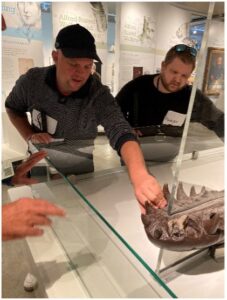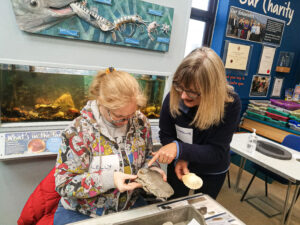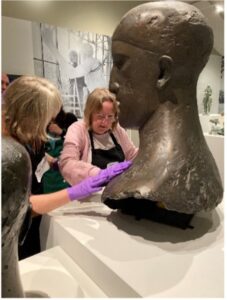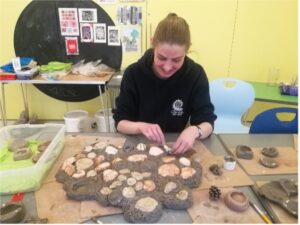GEM Conference 2023: “Sensing the Past”
Funded by Wessex Museums Partnership – A collaborative project with Dorset Museum, Charmouth Heritage Coast Centre and members of the Dorset Blind Association October and November 2022.
Many visually impaired people often feel disconnected and isolated from their environment making them one of the most vulnerable groups during the Covid 19 pandemic. Blind and visually impaired people often experience high levels of anxiety when visiting public spaces. “Sensing the Past,” funded by Wessex Museums Partnerships was created to connect participants with a shared interest in an environment where they felt safe and supported.
Members of the Dorset Blind Association (DBA) were given two on line talks by Earth Scientist and Wessex Museums Partnership engagement lead Dr Anjana Khatwa and Charmouth Heritage Coast Centre (CHCC) warden and engagement lead Anna Holbrook. Two outreach visits to the groups across Dorset were undertaken with handling fossils and objects to inspire interest and participation.
Sessions at Dorset Museum and Charmouth Heritage Coast Centre
The group explored the Dorset coast through a sensory session at Dorset Museum and a visit on location to the Charmouth Heritage Coast Centre in October and November 2022. Fossil and shell casting in clay and plaster at Dorset Museum proved to be very enjoyable, participants experienced the indentation of the fossil in the clay and the setting of the plaster in the clay whilst learning about how fossils are created.
A member of the group explained “The sensory experience is really good as you can feel everything in the plaster first and in the clay you can feel where the fossil has been pushed in and where the plaster cast came out. You can feel every little line, nook and crannie and everything that has come out has been preserved in the plaster cast. It is a very moving impression as because when I had my sight before I can build a picture in my mind of what I am holding in my hand as I move my fingers over each bump.
The group handled a variety of tactile fossils including ammonites, belemnites, echinoids and gastropods, models of creatures and various scent boxes exploring the smells from various time periods such as magnolia for the first flowering plants. High contrast black images were used and accessible for some and helped to illustrate Dorset Museum’s large pliosaur “Kevani” and ancient crocodile “The Swanage snapper”. Specialist input and knowledge was also provided by staff from Charmouth Heritage Coast Centre and knowledgeable staff and volunteers at Dorset Museum. Dorset Museum’s newly redeveloped accessible spaces which include audio displays and tactile objects with braille were very much appreciated by the group.


The visit to Charmouth Heritage Coast Centre encouraged participants to put everything into context from previous sessions. Due to the weather and carefully considered safety factors at Charmouth, the group hunted for fossils in trays of shingle and gravel collected from the coast earlier at the CHCC. Group participants really enjoyed this activity and proved to be very successful.
One DBA group member said “I can feel the shapes so I know roughly what the difference between a fossil and a stone is. Because I have some vision, I can see certain fossils if they are bigger, I can see certain shapes. Touch is a big thing – I have found an ichthyosaur vertebrae, some ammonites and belemnites, you can feel the ridges of the ammonite. It is important to touch as if you are completely blind – other people with worse vision, touch would be a major factor for finding fossils.”
There was a wonderful variety of Charmouth sea weeds in tubs another effective sensory experience for visually impaired people due to the tactile nature of each species and the huge variety of shapes and forms. Participants were treated to many handling objects and incredible ichthyosaurs, where details of their large eyes could be felt as well as other large fossils including the Charmouth scelidosaurus to touch and engage with in addition to the David Attenborough sea dragon. The centre had been closed off to the public so the group had complete access to the space and an accessible ramp and facilities.


Phase 2 of the project
The second phase of the project involved a further visit to Dorset Museum in April 2023 where the group undertook a touch tour of the Elisabeth Frink collection of sculptures in the Dorset Artists Gallery. They painted their previous fossil and shell casts and placed them together using sculptural techniques to form a group art piece inspired by the Death Assemblages at Charmouth Heritage Coast Centre and Dorset Museum. Death assemblages are a collection of creatures that were probably not associated with one another while alive, but were brought together in a fossil formation after their death by currents and other factors. The group piece will go on display in Dorset Museum and at Charmouth Heritage Coast Centre in a specially built display case with audio recordings created throughout the project of group members, volunteers and staff talking about their lived experiences and responses to the project.


What really worked:
- Adopting a co-production approach with the community group to develop and design the engagement programme. Meeting with the group first provided lots of valuable feedback to inform planning.
- Impactful disability awareness training for staff and volunteers concerning the lived experiences of blind and visually impaired people.
- Working with and learning from experts which enhanced and enriched the quality of the content delivered in workshops and talks.
- Collecting audio and visual evaluation from workshop participants, staff and volunteers that informed the development of Phase 2 of the project.
Challenges and how did we overcome them?
The Dorset Blind Associated identified significant risk to the safety of blind and visually impaired people if they were to walk along an uneven shingle beach to experience fossil hunting. Working with the Dorset Blind Association, Charmouth Heritage Coast Centre and museum staff co-designed “fossil hunting” experience trays that allowed participants to safely and enjoyably search for and learn about local Jurassic Coast fossils.
A participant said: “I have never found fossils…I have to have help here today as they just go through my filter because I have never found them, never seen them. It is great to touch them and actually find them…you are learning it in a way you never have before. It’s fascinating to learn at this age…so it means you can still keep learning even if you can’t see and even if you are quite advanced in your age.”
Takeaway points
- Adopt a co-production approach that involves the community group and empowers them to shape and define how they want to work with your museum.
- Ensure that you fully understand the needs and sensitivities of your community group, making adjustments and adaptations as necessary.
- Bring in experts that can enhance your storytelling such as scientists and artists.
- Be patient, genuine co-created projects with underserved communities takes time. The project began with a Zoom talk to an interactive tactile display designed by visually impaired people for visually impaired people.
- One of the group participants is now volunteering with us at Dorset Museum!
Sensing the Past – Wessex Museums
Sensing the Past – Dorset Museum
Alexandra Briggs
Learning and Community Co-ordinator, Dorset Museum
Alexandra Briggs is the Learning and Community Co – ordinator at Dorset Museum; her role involves working with underserved audiences as part of Wessex Museums Partnership. Alexandra worked within education for many years specialising in art and design; she has an interest in the therapeutic impact of art and education for healing and personal growth.
